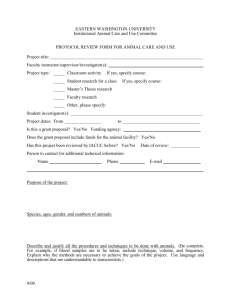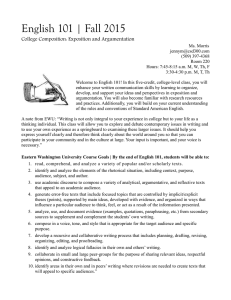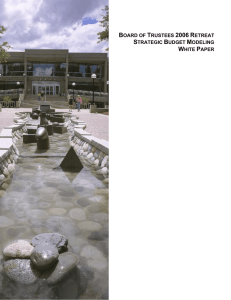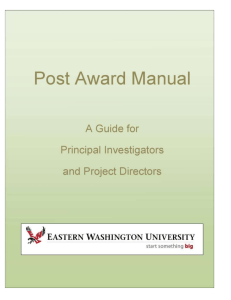Winter-Spring 2016 English 101: College exposition and argument
advertisement
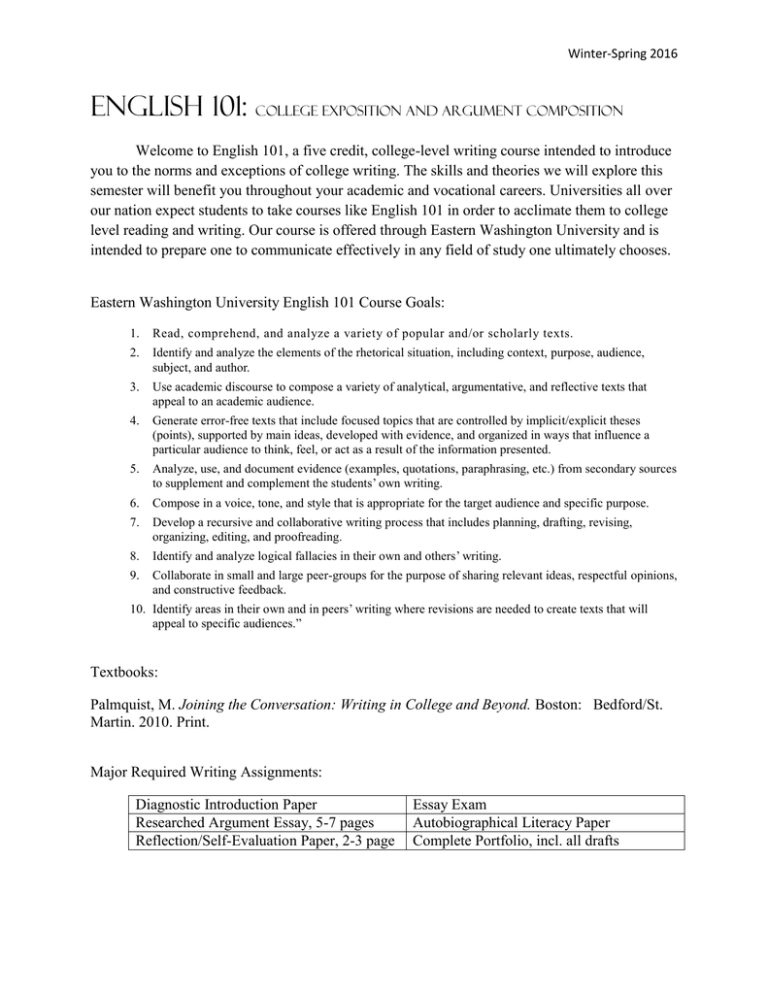
Winter-Spring 2016 English 101: College exposition and argument Composition Welcome to English 101, a five credit, college-level writing course intended to introduce you to the norms and exceptions of college writing. The skills and theories we will explore this semester will benefit you throughout your academic and vocational careers. Universities all over our nation expect students to take courses like English 101 in order to acclimate them to college level reading and writing. Our course is offered through Eastern Washington University and is intended to prepare one to communicate effectively in any field of study one ultimately chooses. Eastern Washington University English 101 Course Goals: 1. Read, comprehend, and analyze a variety of popular and/or scholarly texts. 2. Identify and analyze the elements of the rhetorical situation, including context, purpose, audience, subject, and author. 3. Use academic discourse to compose a variety of analytical, argumentative, and reflective texts that appeal to an academic audience. 4. Generate error-free texts that include focused topics that are controlled by implicit/explicit theses (points), supported by main ideas, developed with evidence, and organized in ways that influence a particular audience to think, feel, or act as a result of the information presented. 5. Analyze, use, and document evidence (examples, quotations, paraphrasing, etc.) from secondary sources to supplement and complement the students’ own writing. 6. Compose in a voice, tone, and style that is appropriate for the target audience and specific purpose. 7. Develop a recursive and collaborative writing process that includes planning, drafting, revising, organizing, editing, and proofreading. 8. Identify and analyze logical fallacies in their own and others’ writing. 9. Collaborate in small and large peer-groups for the purpose of sharing relevant ideas, respectful opinions, and constructive feedback. 10. Identify areas in their own and in peers’ writing where revisions are needed to create texts that will appeal to specific audiences.” Textbooks: Palmquist, M. Joining the Conversation: Writing in College and Beyond. Boston: Bedford/St. Martin. 2010. Print. Major Required Writing Assignments: Diagnostic Introduction Paper Researched Argument Essay, 5-7 pages Reflection/Self-Evaluation Paper, 2-3 page Essay Exam Autobiographical Literacy Paper Complete Portfolio, incl. all drafts Winter-Spring 2016 Portfolio: Be sure to hang on to all your drafts (3) because they will go into the final portfolio along with reflections. Refer to the Writing Portfolio Coversheet Checklist for all that is required by the end of the course. Homework Policy: Homework, readings, and papers are due at the beginning of class for full credit. Group participation: One’s ability to work well with others is a highly valuable skill in school and beyond. Part of your grade will be based on your ability to offer insightful and helpful commentary to your peers. Most major papers will be subjected to peer group workshops. Resources for you: EWU Writers' Center: The Writers’ Center is a free resource for EWU students (that's you!). In one-to-one, online or face-to-face 50-minute sessions, Responders offer thoughtful feedback on any kind of academic or personal writing, at any stage in the writing process. During sessions, Responders encourage students to consider and implement strategies for improving their writing and becoming a more successful writer. The Writers’ Center also provides feedback on forms of visual and digital communication like PowerPoint presentations, posters and websites. For more information about the Writers’ Center and to schedule an appointment with a Responder, visit www.ewu.edu/writerscenter. (One Skype visit required this semester.) EWU Libraries: EWU Libraries provides access to 750,000 books and over 50,000 journals, magazines and newspapers online and in print. Librarians are available to assist students in all of their research needs in person, IM chat, email, or by phone. To access our resources, contact us, or for more information, visit http://www.ewu.edu/library. o Ask Ms. Nielson for library access password and login. Course Work Percent of Final Grade Class work (incl. journals) 35% Participation 10% Essays 45% Final Portfolio 10% Grading Scale 100-93 A 92-90 A89-87 B+ 86-83 B 82-80 B79-77 C+ 76-73 C 72-70 C69-67 D+ 66-63 D 62-0 F Winter-Spring 2016 Major Assignment Guidelines: MLA Format General Guidelines Type your paper on a computer and print it out on standard, white 8.5 x 11-inch paper. Double-space the text of your paper, and use a legible font (e.g. Times New Roman). Whatever font you choose, MLA recommends that the regular and italics type styles contrast enough that they are recognizable one from another. The font size should be 12 pt. Leave only one space after periods or other punctuation marks (unless otherwise instructed by your instructor). Set the margins of your document to 1 inch on all sides. Indent the first line of paragraphs one half-inch from the left margin. MLA recommends that you use the Tab key as opposed to pushing the Space Bar five times. Create a header that numbers all pages consecutively in the upper right-hand corner, one-half inch from the top and flush with the right margin. (Note: Your instructor may ask that you omit the number on your first page. Always follow your instructor's guidelines.) Use italics throughout your essay for the titles of longer works and, only when absolutely necessary, providing emphasis. If you have any endnotes, include them on a separate page before your Works Cited page. Entitle the section Notes (centered, unformatted). Formatting the First Page of Your Paper Do not make a title page for your paper unless specifically requested. In the upper left-hand corner of the first page, list your name, your instructor's name, the course, and the date. Again, be sure to use double-spaced text. Double space again and center the title. Do not underline, italicize, or place your title in quotation marks; write the title in Title Case (standard capitalization), not in all capital letters. Use quotation marks and/or italics when referring to other works in your title, just as you would in your text: Fear and Loathing in Las Vegas as Morality Play; Human Weariness in "After Apple Picking" Double space between the title and the first line of the text. Create a header in the upper right-hand corner that includes your last name, followed by a space with a page number; number all pages consecutively with Arabic numerals (1, 2, 3, 4, etc.), one-half inch from the top and flush with the right margin. (Note: Your instructor or other readers may ask that you omit last name/page number header on your first page. Always follow instructor guidelines.) Visual Example on Next Page Winter-Spring 2016 The Purdue OWL. Purdue U Writing Lab, 2010. Web. August 26,2015.
